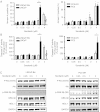Sorafenib decreases proliferation and induces apoptosis of prostate cancer cells by inhibition of the androgen receptor and Akt signaling pathways
- PMID: 22383427
- PMCID: PMC3353237
- DOI: 10.1530/ERC-11-0298
Sorafenib decreases proliferation and induces apoptosis of prostate cancer cells by inhibition of the androgen receptor and Akt signaling pathways
Abstract
Antihormonal and chemotherapy are standard treatments for nonorgan-confined prostate cancer. The effectivity of these therapies is limited and the development of alternative approaches is necessary. In the present study, we report on the use of the multikinase inhibitor sorafenib in a panel of prostate cancer cell lines and their derivatives which mimic endocrine and chemotherapy resistance. (3)H-thymidine incorporation assays revealed that sorafenib causes a dose-dependent inhibition of proliferation of all cell lines associated with downregulation of cyclin-dependent kinase 2 and cyclin D1 expression. Apoptosis was induced at 2 μM of sorafenib in androgen-sensitive cells, whereas a higher dose of the drug was needed in castration-resistant cell lines. Sorafenib stimulated apoptosis in prostate cancer cell lines through downregulation of myeloid cell leukemia-1 (MCL-1) expression and Akt phosphorylation. Although concentrations of sorafenib required for the antitumor effect in therapy-resistant sublines were higher than those needed in parental cells, the drug showed efficacy in cells which became resistant to bicalutamide and docetaxel respectively. Most interestingly, we show that sorafenib has an inhibitory effect on androgen receptor (AR) and prostate-specific antigen expression. In cells in which AR expression was downregulated by short interfering RNA, the treatment with sorafenib increased apoptosis in an additive manner. In summary, the results of the present study indicate that there is a potential to use sorafenib in prostate cancers as an adjuvant therapy option to current androgen ablation treatments, but also in progressed prostate cancers that become unresponsive to standard therapies.
Figures






Similar articles
-
Targeting of distinct signaling cascades and cancer-associated fibroblasts define the efficacy of Sorafenib against prostate cancer cells.Cell Death Dis. 2012 Jan 26;3(1):e262. doi: 10.1038/cddis.2012.1. Cell Death Dis. 2012. PMID: 22278289 Free PMC article.
-
The multikinase inhibitor sorafenib induces caspase-dependent apoptosis in PC-3 prostate cancer cells.Asian J Androl. 2010 Jul;12(4):527-34. doi: 10.1038/aja.2010.21. Epub 2010 May 17. Asian J Androl. 2010. PMID: 20473320 Free PMC article.
-
Sorafenib induces growth inhibition and apoptosis in human synovial sarcoma cells via inhibiting the RAF/MEK/ERK signaling pathway.Cancer Biol Ther. 2009 Sep;8(18):1729-36. doi: 10.4161/cbt.8.18.9208. Epub 2009 Sep 6. Cancer Biol Ther. 2009. PMID: 19633425
-
AR, the cell cycle, and prostate cancer.Nucl Recept Signal. 2008 Feb 1;6:e001. doi: 10.1621/nrs.06001. Nucl Recept Signal. 2008. PMID: 18301781 Free PMC article. Review.
-
Treatment of castration-resistant prostate cancer: updates on therapeutics targeting the androgen receptor signaling pathway.Am J Ther. 2010 Mar-Apr;17(2):176-81. doi: 10.1097/MJT.0b013e3181c6c0b2. Am J Ther. 2010. PMID: 20019584 Free PMC article. Review.
Cited by
-
In silico design and molecular docking study of CDK2 inhibitors with potent cytotoxic activity against HCT116 colorectal cancer cell line.J Genet Eng Biotechnol. 2020 Sep 15;18(1):51. doi: 10.1186/s43141-020-00066-2. J Genet Eng Biotechnol. 2020. PMID: 32930901 Free PMC article.
-
Enhanced anticancer activity of a combination of docetaxel and Aneustat (OMN54) in a patient-derived, advanced prostate cancer tissue xenograft model.Mol Oncol. 2014 Mar;8(2):311-22. doi: 10.1016/j.molonc.2013.12.004. Epub 2013 Dec 15. Mol Oncol. 2014. PMID: 24388358 Free PMC article.
-
Network pharmacology and molecular docking reveal the mechanism of action of Bergapten against non‑small cell lung cancer.Oncol Lett. 2024 Dec 4;29(2):87. doi: 10.3892/ol.2024.14833. eCollection 2025 Feb. Oncol Lett. 2024. PMID: 39677411 Free PMC article.
-
Synergistic antitumour activity of sorafenib in combination with tetrandrine is mediated by reactive oxygen species (ROS)/Akt signaling.Br J Cancer. 2013 Jul 23;109(2):342-50. doi: 10.1038/bjc.2013.334. Epub 2013 Jun 27. Br J Cancer. 2013. PMID: 23807172 Free PMC article.
-
Updates on Overcoming Bicalutamide Resistance: A Glimpse into Resistance to a Novel Antiandrogen.ACS Pharmacol Transl Sci. 2024 Mar 7;7(4):905-914. doi: 10.1021/acsptsci.3c00299. eCollection 2024 Apr 12. ACS Pharmacol Transl Sci. 2024. PMID: 38633597 Free PMC article. Review.
References
-
- Aragon-Ching JB, Jain L, Gulley JL, Arlen PM, Wright JJ, Steinberg SM, Draper D, Venitz J, Jones E, Chen CC, et al. Final analysis of a phase II trial using sorafenib for metastatic castration-resistant prostate cancer. British Journal of Urology International. 2009;103:1636–1640. doi: 10.1111/j.1464-410X.2008.08327.x. - DOI - PMC - PubMed
-
- Beardsley EK, Hotte SJ, North S, Ellard SL, Winquist E, Kollmannsberger C, Mukherjee SD, Chi KN. A phase II study of sorafenib in combination with bicalutamide in patients with chemotherapy-naive castration resistant prostate cancer. Investigational New Drugs. 2012:[in press]. - PubMed
-
- Cavarretta IT, Neuwirt H, Untergasser G, Moser PL, Zaki MH, Steiner H, Rumpold H, Fuchs D, Hobisch A, Nemeth JA, et al. The antiapoptotic effect of IL-6 autocrine loop in a cellular model of advanced prostate cancer is mediated by Mcl-1. Oncogene. 2007;26:2822–2832. doi: 10.1038/sj.onc.1210097. - DOI - PubMed
-
- Chapuy B, Schuelper N, Panse M, Dohm A, Hand E, Schroers R, Truemper L, Wulff GG. Multikinase inhibitor sorafenib exerts cytocidal efficacy against non-Hodgkin lymphomas associated with inhibition of MAPK14 and AKT phosphorylation. British Journal of Haematology. 2011;152:401–412. doi: 10.1111/j.1365-2141.2010.08526.x. - DOI - PubMed
Publication types
MeSH terms
Substances
Grants and funding
LinkOut - more resources
Full Text Sources
Medical
Research Materials

